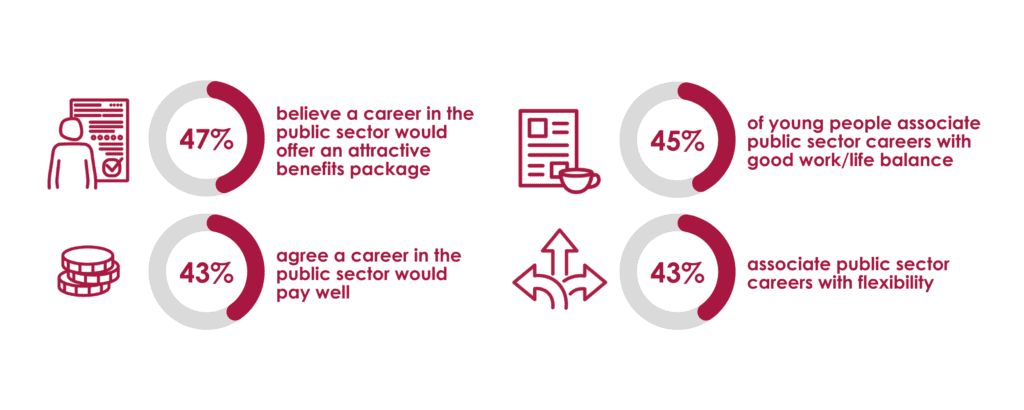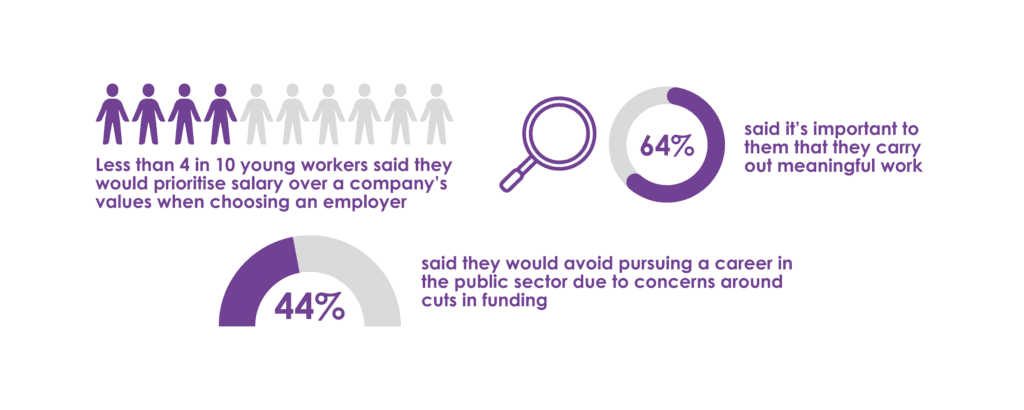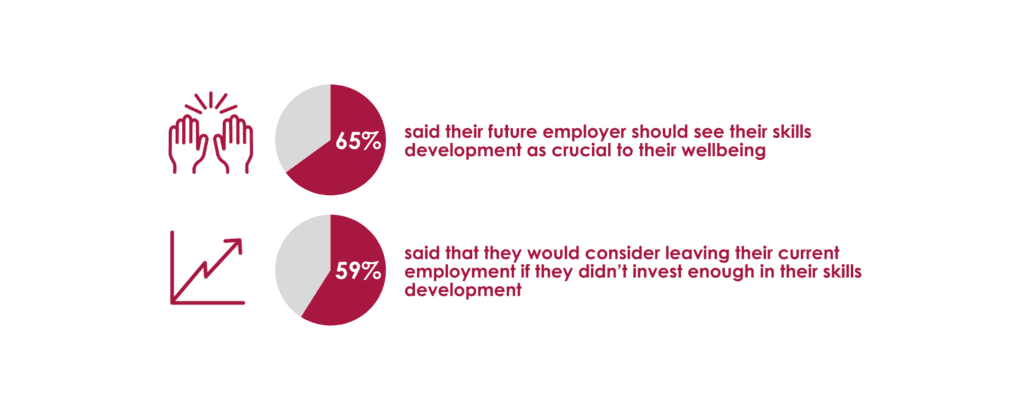
Young people want to work in the public sector, so why does it struggle with recruitment?
23/03/2024
Contrary to beliefs that the public sector lacks attractive career prospects for young people, our research of 18 to 25-year-olds has revealed it to be one of the most appealing sectors to build a long-term career.
Positive perceptions of a career in the public sector
When asked to rank sectors in order of most to least attractive, young people placed the public sector comfortably in the top half, after careers in creative and media, health and social care including pharma, and financial services.
Numerous factors were behind the positive perception of this career path including competitive remuneration, a good work/life balance, and flexibility.
While the survey did highlight many positive reasons behind young people wanting to enter the sector, data suggested a disconnect between those then going on to pursue a career in it. The latest LGA figures show that under 25s make up just 4.6% of the workforce, while more than 70% of local government employees are over the age of 40. On top of this, with 62% of HMRC senior staff over 50 years old, it is estimated that many will retire within the next 15 years. This presents real concern around the future of the sector.
On top of this, the latest Government Skills Survey found that public sector establishments were more likely to have skills gaps (21%) compared to private sector bodies and charity or voluntary sector establishments (15%).
However, our research clearly shows that there is an untapped market of young talent who find these roles appealing, despite the aforementioned challenges. They can add capacity, skill, and drive forward key sector strategies at a time when recruitment is under pressure. What now needs to happen is the sector must ensure it is doing everything it can to convert this interest into fulfilling careers.

What’s preventing greater uptake of public sector roles?
A crucial first step is taking a look at what the blockers are and then taking steps to overcome these. According to the House of Lords Public Services Committee report, ‘Fit for the future? Rethinking the public services workforce’, “A job for life with a good pension is no longer a strong enticement. Instead, young people seek roles where they can grow, where their skills can be developed and brought to bear in their roles, and where they can ready themselves for their next steps”, therefore roles must be “rewarding, challenging, and constantly enable development.”
Our research cemented this, indicating remuneration and working patterns aren’t the most important factors for young people when choosing a career. In fact, fewer than four in 10 young workers said they would prioritise salary over a company’s values when choosing an employer, and 64% said it’s important to them that they carry out meaningful work, suggesting the ability to impact social value is an attractive selling point of the public sector among young people.
Other blockers were highlighted by the research including concern around cuts in funding, with 44% saying they would avoid pursuing a career in the public sector for this reason.
Moreover, public sector roles can often be stereotyped as bureaucratic and slow-moving, which may deter young people from seeking dynamic and innovative work environments. There is further research to support the perception that public sector organisations are resistant to change or innovation can further discourage potential candidates who value adaptability and creativity in their careers.
Negative perceptions of work culture, such as hierarchical management styles, excessive bureaucracy, and lack of autonomy, can also discourage individuals from considering a role in any sector. A culture that values hierarchy over meritocracy will always fail to foster a supportive and inclusive work environment can contribute to attrition and difficulty in attracting top talent. The public sector can lead the way in dismantling these stereotypes and championing an inviting and attractive workplace for young people.

The need for change and transformation in the public sector
The research highlights that the public sector needs to change in order to convert young people’s interests into fulfilling careers in the industry. There are opportunities for the sector to shift perceptions and make necessary changes.
One of the biggest gaps – but greatest opportunities – is change and transformation. The public sector has historically been behind other sectors in this area. With just 4% of civil servants working in digital roles compared with an average of between 8-12% in other sectors, there is still room for more to be done.
There’s a significant opportunity for public sector organisations to capitalise on the need for change and transformation. With the right workforce, this means freeing up vital resources – a crucial area of focus for the Government’s latest Public Sector Productivity Plan - improving services, and driving social value.
In order to attract and retain new talent therefore, public sector organisations need to be investing in the skills development of their employees. In fact, 65% said their future employer should see their skills development as crucial to their wellbeing and 59% said that they would consider leaving their current employment if they didn’t invest enough in their skills. Young people are clearly keen to learn and develop.
Public sector organisations should also look at improving their culture and wellbeing programmes to attract new talent. This will help tackle negative perceptions, such as the stereotypes that it is bureaucratic and slow-moving with a lack of autonomy.
Our reverse mentoring programme is a useful tactic to help achieve this and to tap into the potential of the emerging workforce. This is a scheme which sees junior colleagues taking on the role of a mentor to senior colleagues, providing an opportunity for all employees to safely share their views. It enables both participants to feel heard, developing richer, more useful perspectives by removing some of the traditional hierarchical barriers to shared learning. During our programme, 100% of respondents found their involvement in the scheme to be 'valuable' or 'extremely valuable' and more than two in three believed they felt more engaged with the Grayce community as a result of participating.
By embedding it as a tool, organisations can unlock the vast knowledge, experiences, and skills of the emerging workforce. Not only strengthening relationships but also contributing to a more inclusive and appealing culture where employees feel accepted and heard.
The public sector must adapt to the evolving needs and aspirations of the emerging workforce, otherwise it risks losing out on top skills and talent, whilst increasing costs and decreasing efficiencies. This means a focus on meaningful work, skills development, and embracing change and innovation. By investing in upskilling initiatives, fostering inclusive cultures, and implementing strategies like reverse mentoring, public sector organisations can not only attract but also retain top talent.





